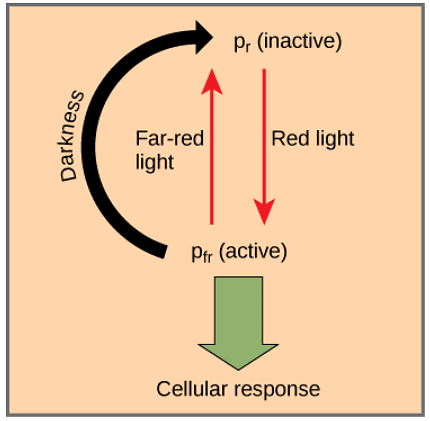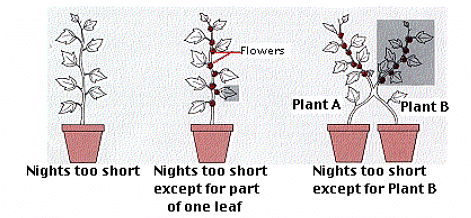Photoperiodism | Botany Optional for UPSC PDF Download
Introduction
The concept of photoperiodism plays a pivotal role in understanding how plants respond to seasonal changes. In this article, we will delve into the intricate mechanisms of photoperiodism, explore the different categories of plants based on their response to day length, and uncover the fascinating world of circadian rhythms in plants.
Detecting Seasonal Changes
Plants, like animals, have evolved sophisticated ways to adapt to their environment. While temperature and light intensity can influence plant growth, they are not reliable indicators of seasonality due to their variability from year to year. Instead, day length serves as a more dependable cue for the changing seasons. Many angiosperms consistently bloom at the same time each year, regardless of when they started growing. This remarkable synchrony is a result of their response to the changing duration of day and night, a phenomenon known as photoperiodism.
The Phytochrome System: Nature's Light Switch
To comprehend photoperiodism, we must acquaint ourselves with the phytochrome system. Phytochromes are a family of photoreceptors found in plants, consisting of five distinct types: PhyA, PhyB, PhyC, PhyD, and PhyE. These photoreceptors are chromoproteins containing a light-absorbing molecule similar to chlorophyll. The key to understanding their function lies in their ability to exist in two interconvertible forms: Pr (absorbing red light) and Pfr (absorbing far-red light).
Figure: The biologically inactive form of phytochrome (Pr) is converted to the biologically active form Pfr under illumination with red light. Far-red light and darkness convert the molecule back to the inactive form.
The phytochrome system acts as a biological light switch, monitoring the level, intensity, duration, and color of environmental light. Exposure to red light activates Pfr, while far-red light inhibits phytochrome activity. This system's complexity allows plants to sense the length of day and night and adjust their physiology accordingly.
Short-Day, Long-Day, and Day-Neutral Plants
Photoperiodism categorizes plants into three main groups: short-day, long-day, and day-neutral plants.
- Short-Day Plants: These plants require nights longer than a critical duration, typically eight or fewer hours, to induce flowering. Exposure to light during the dark period interrupts this process.
- Long-Day Plants: In contrast, long-day plants bloom when nights are shorter than a critical length, typically between eight to 15 hours.
- Day-Neutral Plants: Some plants, like tomatoes, are not influenced by day length when it comes to flowering.
The diverse responses of these plants to photoperiodism provide insights into their geographical distribution and adaptability to different climates.
Unraveling the Mystery of Florigen
The initiation of flowering in plants involves a fascinating chemical signal called florigen. This signal is produced in the leaves and transmitted to the apical meristems, triggering the transformation into floral meristems. While the precise composition of florigen has been a subject of research for years, recent evidence suggests that the protein encoded by the gene FLOWERING LOCUS T (FT) is a significant component.
Figure: The cocklebur needs at least 8.5 hours of darkness in order to flower. Grafting a cocklebur (B) that receives the required period of darkness to one (A) that does not causes flowering in both. Evidently the florigen signal passes from B to A through their connected vascular systems.
Florigen's influence is so potent that even if only a portion of one leaf is exposed to the correct photoperiod, the entire plant will bloom.
Career Connection: Horticulturist
The field of horticulture has witnessed a transformation due to our growing understanding of plant responses to environmental cues. Horticulturists, responsible for the cultivation of crops, fruits, vegetables, and flowers, can now manipulate plants to enhance production. They achieve this through various methods such as adjusting day length using blackout shade cloths or providing specific light wavelengths. Additionally, the timing of fruit ripening can be controlled through the application of plant hormones.
Figure: Horticulturalist Anderson Ifui (left) with Jack McGilchrist, the technical adviser for the Australian Volunteer Initiative (right), at Honiara Botanic gardens in the Solomon Islands in 2004. Image by Peter Davis/AusAID (CC-BY).
Horticulturists find employment in diverse settings, including laboratories, greenhouses, botanical gardens, and research fields. Their knowledge of genetics and plant physiology is essential in improving crop yield and quality.
Circadian Rhythms: Nature's 24-Hour Clock
- In addition to photoperiodism, plants also exhibit circadian rhythms, which are biological processes that follow a 24-hour cycle.
- For instance, some flowers open and close at specific times of the day, and other physiological processes like photosynthesis and scent production can be influenced by these rhythms. In the absence of external cues, circadian rhythms may drift out of phase with the environment, but exposure to day-night cycles entrains them to a 24-hour cycle.
- Circadian rhythms in plants are closely tied to the detection of light by phytochromes and cryptochromes, highlighting the intricate interplay between light and plant biology.
Conclusion
Photoperiodism and circadian rhythms are intricate aspects of plant biology that govern how plants respond to seasonal changes and daily cycles. Understanding these mechanisms not only deepens our appreciation of the natural world but also has practical applications in agriculture and horticulture, revolutionizing the way we cultivate crops and manipulate plant growth. As we continue to unravel the mysteries of these biological clocks, we gain valuable insights into the remarkable adaptability of plants to their ever-changing environments.
|
179 videos|143 docs
|
FAQs on Photoperiodism - Botany Optional for UPSC
| 1. What is the role of the phytochrome system in detecting seasonal changes? |  |
| 2. What are short-day, long-day, and day-neutral plants? |  |
| 3. What is florigen and how does it contribute to unraveling the mystery of flowering? |  |
| 4. What is the role of a horticulturist in relation to the topics discussed in this article? |  |
| 5. How do circadian rhythms contribute to nature's 24-hour clock? |  |
















